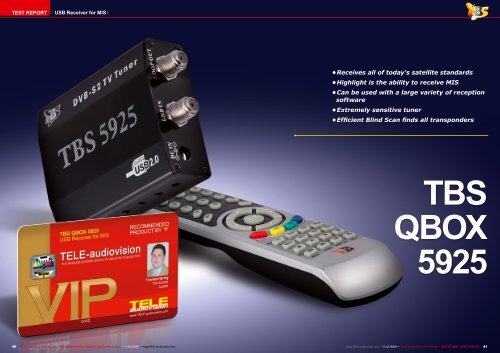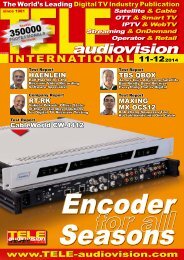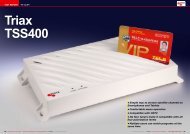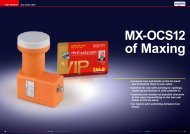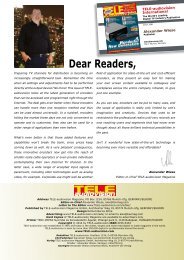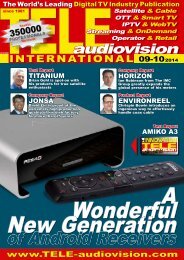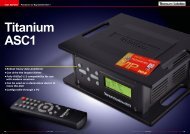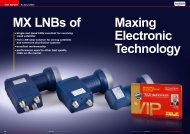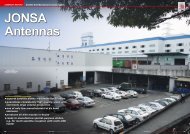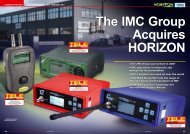TBS QBOX 5925
You also want an ePaper? Increase the reach of your titles
YUMPU automatically turns print PDFs into web optimized ePapers that Google loves.
TEST REPORT<br />
USB Receiver for MIS<br />
• Receives all of today's satellite standards<br />
• Highlight is the ability to receive MIS<br />
• Can be used with a large variety of reception<br />
software<br />
• Extremely sensitive tuner<br />
• Efficient Blind Scan finds all transponders<br />
<strong>TBS</strong><br />
<strong>QBOX</strong><br />
<strong>5925</strong><br />
40 TELE-audiovision International — The World‘s Leading Digital TV Industry Publication — 11-12/2014 — www.TELE-audiovision.com<br />
www.TELE-audiovision.com — 11-12/2014 — TELE-audiovision International — 全 球 发 行 量 最 大 的 数 字 电 视 杂 志 41
TEST REPORT<br />
USB Receiver for MIS<br />
USB DVB-S2 Receiver<br />
for Multi Input Streams<br />
It wasn‘t too long ago<br />
when we introduced to you<br />
here in TELE-audiovision a<br />
solution for the reception<br />
of MIS (Multi Input Stream)<br />
frequencies in the form of a<br />
PCI card from Tenow for a<br />
PC (see TELE-satellite issue<br />
12-01/2012). Now Tenow has<br />
developed another device<br />
that can be used to receive<br />
MIS: the <strong>TBS</strong> <strong>QBOX</strong> <strong>5925</strong> is<br />
the first USB compatible MIS<br />
box.<br />
The <strong>QBOX</strong> is about the size<br />
of a pack of cigarettes and<br />
is enclosed in a high-quality<br />
metal housing. On one side<br />
of the box you‘ll find the USB<br />
■<br />
TELE-audiovision first presented the new<br />
MIS technology in issue 12-01/2012. Read<br />
the full report here:<br />
http://www.tele-audiovision.com/<br />
TELE-satellite-1201/eng/tenow-<strong>TBS</strong>6925.pdf<br />
port for connection to a PC,<br />
an IR receiver as well as two<br />
status LEDs. On the other<br />
side there‘s the tuner input<br />
with looped-through output<br />
plus the connection for the<br />
external 12V power supply.<br />
The remote control included<br />
by the manufacturer is very<br />
practical and impressed us<br />
just as much as the box itself<br />
with its high-quality workmanship.<br />
The tuner in the <strong>TBS</strong> <strong>QBOX</strong><br />
<strong>5925</strong> can receive signals in<br />
the 950-2150 MHZ frequency<br />
range with an input signal<br />
level from -69 to -23dBm.<br />
It can work with symbolrates<br />
from 0.2 to 45 Ms/s<br />
in both DVB-S and DVB-S2<br />
modes and also supports all<br />
the popular demodulation<br />
modes, namely 8PSK, QPSK,<br />
16APSK and 32 APSK. The<br />
<strong>TBS</strong> <strong>QBOX</strong> does not place<br />
any extreme requirements<br />
on the PC it will be connected<br />
to; for DVB-S reception a<br />
1 GHz Pentium III CPU with<br />
256 MB of memory is good<br />
enough. For DVB-S2 reception<br />
a machine with a 3 GHz<br />
Pentium IV CPU and 1GB of<br />
memory is recommended. A<br />
free USB port is also necessary<br />
and shouldn‘t present<br />
11-12/2014<br />
0.54<br />
<strong>TBS</strong> <strong>QBOX</strong> <strong>5925</strong><br />
Best suited<br />
for real satellite enthusiasts<br />
www.TELE-audiovision.com/14/11/tenow<br />
42 TELE-audiovision International — The World‘s Leading Digital TV Industry Publication — 11-12/2014 — www.TELE-audiovision.com
1<br />
3<br />
7<br />
MIS Reception<br />
1. The user can select the desired MIS stream with the help of the<br />
TS Recorder<br />
2. Storing an MIS stream<br />
3. Scan of an MIS frequency with <strong>TBS</strong>Viewer<br />
4. Reception of channels on an MIS frequency with <strong>TBS</strong>Viewer<br />
5. Scan of an MIS frequency with <strong>TBS</strong>Viewer<br />
6. Reception of channels on an MIS frequency with <strong>TBS</strong>Viewer<br />
7. Scan of an MIS frequency with ProgDVB<br />
8. Reception of channels on an MIS frequency with ProgDVB<br />
9. Scan of an MIS frequency with ProgDVB<br />
10. Reception of channels on an MIS frequency with ProgDVB<br />
8<br />
4<br />
9<br />
2<br />
10<br />
5<br />
6<br />
any problems. As far as the<br />
PCs operating system, all<br />
Windows versions starting<br />
with XP as well as Linux are<br />
supported.<br />
We found it interesting<br />
that, although Tenow has<br />
their own DVB reception tool<br />
that goes by the name of TB-<br />
SViewer, they freely suggest<br />
alternative software solutions.<br />
In particular, there‘s<br />
DVBDream, DVBViewer,<br />
DVBLogic, DVBControl, MediaPortal,<br />
TVheadend, Prog-<br />
DVB, MuMuDVB or DVBLast.<br />
In this way you can use your<br />
favorite software. If you‘re<br />
not sure which program<br />
you should use, nearly all<br />
of them offer free trial versions<br />
that you can download<br />
from the Internet so you can<br />
test them out. In any case<br />
though, they all offer a much<br />
wider range of functions<br />
compared to the rather rudimentary<br />
<strong>TBS</strong>Viewer.<br />
Because of this we won‘t<br />
be talking about the everyday<br />
use of the <strong>TBS</strong> <strong>QBOX</strong><br />
<strong>5925</strong> in this test report; all of<br />
the available DVB reception<br />
tools are too different from<br />
each other in their capabilities<br />
and their expandability.<br />
We are much more interested<br />
in a special feature of the<br />
<strong>TBS</strong> <strong>QBOX</strong> <strong>5925</strong> that makes<br />
it stand out above all the<br />
other USB DVB-S2 reception<br />
solutions on the market:<br />
namely the ability to receive<br />
VCM/ACM signals as well as<br />
MIS signals. What do these<br />
terms mean and what are<br />
they all about?<br />
There are several ways to<br />
transmit the data of a transponder<br />
via satellite. The<br />
standard that has been used<br />
thus far and the technology<br />
that is used by all the<br />
other standard receivers is<br />
called CCM (Constant Coding<br />
and Modulation). With this<br />
44 TELE-audiovision International — The World‘s Leading Digital TV Industry Publication — 11-12/2014 — www.TELE-audiovision.com<br />
www.TELE-audiovision.com — 11-12/2014 — TELE-audiovision International — 全 球 发 行 量 最 大 的 数 字 电 视 杂 志 45
11 12<br />
13 14<br />
Blindscan<br />
11. Blindscan Tool for the <strong>TBS</strong> <strong>QBOX</strong> <strong>5925</strong><br />
12. The BlindScan tool can recognize transponders with very low<br />
as well as very high symbolrates. Even MIS transponders were<br />
instantly recognized.<br />
13. TS Recorder can store the selected transponder stream in a TS<br />
file on the hard drive of a PC.<br />
14. Results of a BlindScan of HOTBIRD at 13° east. A total of 120<br />
active transponders were found.<br />
standard a satellite channel<br />
is transmitted with a fixed<br />
modulation mode and error<br />
correction code. In other<br />
words, all of the receivers<br />
wherever they may be in<br />
the footprint of the satellite<br />
receive the same signal and<br />
process it identically.<br />
At first glance this technology<br />
appears to be logical and<br />
correct but if you look again<br />
you‘ll recognize the disadvantage:<br />
since they are all<br />
receiving the same signal,<br />
the receivers cannot react<br />
the same way to especially<br />
strong signals in a satellite‘s<br />
primary footprint as they<br />
can with especially weaker<br />
signals in the outer edges<br />
of the same satellite‘s footprint.<br />
With stronger signals<br />
a smaller error correction<br />
is required and a more efficient<br />
modulation would suffice<br />
but with weaker signals<br />
it‘s the other way around: a<br />
46 TELE-audiovision International — The World‘s Leading Digital TV Industry Publication — 11-12/2014 — www.TELE-audiovision.com
more complex error correction<br />
would be needed as well<br />
as a less efficient modulation<br />
mode in order to be able to<br />
receive a good-enough signal.<br />
That‘s why VCM/ACM was<br />
developed. The strategy behind<br />
VCM/ACM (Variable Coding<br />
and Modulation/Adaptive<br />
Coding and Modulation) is<br />
that the entire bandwidth of a<br />
transponder is split into multiple<br />
parts and by employing<br />
various modulation and error<br />
correction methods the<br />
resulting bandwidth sections<br />
can now be occupied with<br />
different programming content<br />
that corresponds to the<br />
available bandwidth.<br />
An example of this would<br />
be the transmission of an HD<br />
channel in a satellite‘s primary<br />
footprint and an SD channel<br />
at the outer edges.<br />
The receivers used in the<br />
satellite‘s primary footprint<br />
can have very small error<br />
correction along with an efficient<br />
modulation such that<br />
high data rates can be transmitted.<br />
But at the same time,<br />
the lower the received signal<br />
level as you move towards<br />
the outer edges of the footprint,<br />
a better error correction<br />
and more reliable modulation<br />
would be needed.<br />
This all takes place within<br />
a transponder, in other<br />
words, with VCM the same<br />
transponder transmits using<br />
different modulations and<br />
error correction methods.<br />
In this case we are talking<br />
about MIS (Multiple Input<br />
Streams). This means that<br />
the receiver can receive multiple<br />
transponder streams<br />
from one transponder that<br />
were transmitted completely<br />
independent of each other<br />
and therefore could have different<br />
modulation and error<br />
correction methods in use.<br />
From the large number<br />
of transponder streams, an<br />
MIS-compatible receiver<br />
looks for those streams that<br />
can be received with sufficient<br />
quality. In the satellite‘s<br />
primary footprint this would<br />
be those streams carrying<br />
HD channels while at the outer<br />
edges of the footprint, it<br />
would be those streams with<br />
SD channels. But we‘re not<br />
quite there yet; the desired<br />
streams must still be selected<br />
manually - as long as an<br />
MIS-compatible receiver is<br />
used. These streams can not<br />
(yet) be received with today‘s<br />
normal DVB-S2 receivers.<br />
VCM was developed with<br />
the normal TV viewer in<br />
mind since in this case the<br />
individual streams are transmitted<br />
with constant values.<br />
ACM, on the other hand, was<br />
developed with professional<br />
applications in mind, such as<br />
for feeds. Here the reception<br />
quality can be sent back to<br />
the broadcaster through a<br />
return channel so that the<br />
modulation and error correction<br />
can be adapted as<br />
needed.<br />
One of the few boxes available<br />
that can receive this kind<br />
of technology is the <strong>QBOX</strong>.<br />
The included <strong>TBS</strong>Viewer<br />
from Tenow and most of the<br />
other available DVB reception<br />
tools are currently not<br />
able to correctly process MIS<br />
frequencies.<br />
That‘s why Tenow has<br />
made available for download<br />
a small tool that goes by the<br />
name of TS Recorder; with<br />
the help of the tuner box, it<br />
will let you dial in the desired<br />
MIS stream so that a matching<br />
signal can be made available<br />
to the DVB reception<br />
software. But there‘s a certain<br />
procedure to follow if you<br />
want to change MIS streams:<br />
first you have to exit out of<br />
the DVB reception software<br />
and then start TS Recorder.<br />
From there you would select<br />
the desired new stream and<br />
then switch back to the DVB<br />
reception software.<br />
The TS Recorder can be<br />
individually adapted to the<br />
available reception system<br />
whereby the local oscillator<br />
frequencies (LOFs), the<br />
switching point between low<br />
and high band as well as<br />
the DiSEqC 1.0 parameters<br />
can be entered individually.<br />
The user then simply needs<br />
to select the desired reception<br />
frequency, polarization<br />
and symbolrate of the MIS<br />
transponder. Once this is all<br />
taken care of, all that‘s needed<br />
is a click of the „Lock TP“<br />
button after which the software<br />
will read in the desired<br />
transponder.<br />
More information on the<br />
selected transponder can be<br />
found near the bottom of the<br />
window as well as the „Input<br />
Stream Identify“ field with a<br />
choice of one or more numbers<br />
that indicate each of the<br />
existing transport streams<br />
from that transponder. Here<br />
you simply choose on one of<br />
the choices and then click<br />
on one of the entries. At this<br />
point you can exit out of TS<br />
Recorder and a scan of the<br />
desired MIS frequency in the<br />
DVB reception software results<br />
in the desired stream.<br />
This procedure can be repeated<br />
as often as necessary<br />
until all of the streams<br />
shown in the „Input Stream<br />
Identify“ field have been selected<br />
and processed. And<br />
there you have it! With each<br />
newly selected stream, the<br />
DVB reception software recognizes<br />
completely different<br />
channels all on the same frequency.<br />
Another more comfortable<br />
option to use is ProgDVB<br />
(www.progdvb.com), that in<br />
its current version can work<br />
with MIS frequencies without<br />
any extra help or external<br />
tools; even the free<br />
standard version can do it.<br />
For our actual tests we<br />
used the 12718 MHz transponder<br />
on EUTELSAT 12<br />
WEST A at 12.5° west on<br />
which there are four transponder<br />
streams that are<br />
totally independent from<br />
each other. We had no trouble<br />
accessing the completely<br />
different channels on each<br />
individual transport stream<br />
as well as switching between<br />
the streams. Naturally, all<br />
of the features you‘re used<br />
to seeing, such as EPG and<br />
language selection, are all<br />
available with MIS reception<br />
except that now multiple<br />
transport streams can be received<br />
on one and the same<br />
frequency. It was also worth<br />
checking out the 11914H<br />
transponder on ASTRA 1G<br />
at 31.5° east where there<br />
are a total of three different<br />
transponder streams carried<br />
on a single frequency. Here<br />
too our test of MIS reception<br />
using the <strong>TBS</strong> <strong>QBOX</strong> <strong>5925</strong><br />
worked perfectly. And the<br />
relatively high symbolrate of<br />
35610 Ks/s used on EUTEL-<br />
SAT 12 WEST A‘s 12718 MHZ<br />
transponder did not create<br />
any problems.<br />
In addition to MIS reception,<br />
Tenow also developed<br />
a BlindScan tool for the <strong>TBS</strong><br />
<strong>QBOX</strong> <strong>5925</strong>‘s tuner that<br />
proved itself quite capable<br />
in our tests. Just about eight<br />
minutes was needed to identify<br />
120 active transponders<br />
on the HOTBIRD satellite at<br />
13° east; that‘s a few more<br />
than you might find in many<br />
frequency lists.<br />
The BlindScan tool can be<br />
customized by the user to<br />
his specific needs. Whether<br />
More about this company<br />
www.TELE-audiovision.com/11/03/tenow<br />
you want to search a specific<br />
frequency range, one<br />
polarization or just a single<br />
band, you‘ll find all of the<br />
necessary settings capabilities<br />
presented in an easy<br />
to understand format. The<br />
results of a BlindScan can<br />
be easily exported to a file<br />
which can then be imported<br />
and utilized by, for example,<br />
DVBViewer or ProgDVB.<br />
In our tests the <strong>TBS</strong> <strong>QBOX</strong><br />
<strong>5925</strong> showed us that with its<br />
BlindScan it was quite capable<br />
of correctly and reliably<br />
recognizing and processing<br />
transponders with very low<br />
expert<br />
OPINION<br />
+ ● Excellent workmanship<br />
● Powerful tuner<br />
● Manufacturer‘s own tools to optimize all of the <strong>TBS</strong> <strong>QBOX</strong><br />
<strong>5925</strong>‘s functions<br />
● Perfect MIS reception with the help of the free ProgDVB version<br />
–<br />
● None<br />
<strong>TBS</strong> <strong>QBOX</strong> <strong>5925</strong><br />
USB Receiver for MIS<br />
ENERGY<br />
DIAGRAM<br />
symbolrates as well as those<br />
transponders that were very<br />
close to each other.<br />
The <strong>TBS</strong> <strong>QBOX</strong> <strong>5925</strong> is a<br />
many-facetted and practical<br />
DVB-S2 receiver for the PC<br />
and thanks to its exceptional<br />
tuner can easily handle weak<br />
or narrowband signals. MIS<br />
reception with VCM/ACM is<br />
a feature that for now is really<br />
only important to satellite<br />
enthusiasts but, because<br />
of its significant cost savings<br />
potential, will without a<br />
doubt also become interesting<br />
for everyday users in the<br />
future.<br />
RECOMMENDED<br />
PRODUCT BY<br />
Thomas Haring<br />
Test Center<br />
Austria<br />
Apparent Power<br />
Active Power<br />
Mode Apparent Active Factor<br />
Active 12 W 6.5 W 0.54<br />
StandBy 9.5 W 4.5 W 0.47<br />
The first 15 minutes active operation with signal reception, the second<br />
15 minutes standby<br />
48 TELE-audiovision International — The World‘s Leading Digital TV Industry Publication — 11-12/2014 — www.TELE-audiovision.com<br />
www.TELE-audiovision.com — 11-12/2014 — TELE-audiovision International — 全 球 发 行 量 最 大 的 数 字 电 视 杂 志 49


